Fly Fishing for Trout
Fly Fishing for Trout
The Next Level
Tom Rosenbauer

STACKPOLE
BOOKS
Guilford, Connecticut
Published by Stackpole Books
An imprint of Globe Pequot
Trade Division of The Rowman & Littlefield Publishing Group, Inc.
4501 Forbes Boulevard, Suite 200, Lanham, Maryland 20706
Distributed by
NATIONAL BOOK NETWORK
800-462-6420
Copyright 2017 by Stackpole Books
Photography by Tom Rosenbauer
Animations by Josh Lokan
All rights reserved. No part of this book may be reproduced in any form or by any electronic or mechanical means, including information storage and retrieval systems, without written permission from the publisher, except by a reviewer who may quote passages in a review.
British Library Cataloguing in Publication Information Available
Library of Congress Cataloging-in-Publication Data
ISBN 978-0-8117-1346-7 (paperback)
ISBN 978-0-8117-6557-2 (e-book)
 The paper used in this publication meets the minimum requirements of American National Standard for Information SciencesPermanence of Paper for Printed Library Materials, ANSI/NISO Z39.48-1992.
The paper used in this publication meets the minimum requirements of American National Standard for Information SciencesPermanence of Paper for Printed Library Materials, ANSI/NISO Z39.48-1992.
To my kids, the two Bs
Contents
Acknowledgments
T here are many more people than those listed here who have shared their perceptive knowledge about trout behavior and trout fishing over the years, and I know I have left many of them out. This was not intentional but can be blamed on my onset of senior moments. In particular, for this book I would like to thank Chris Alexopoulos, Lewis Coleman, Shawn Combs, George Daniel, Kirk Deeter, John Herzer, Kurt Herzer, Spencer Higa, Dave Jensen, Amelia Jensen, Kory Kapaloski, Jeremy Kennedy, Colin McKeown, Sam Orvis, John Packer, Mark Raisler, and Paul Roos.
Fishing images and videos arent very compelling without people in them. Many of the people listed here didnt realize they were models, but I hope they realize the companionship and laughs theyve given me over the past few years on trout water: John Arlotta, Kelly Bastone, Monte Burke, Jeremy Cameron, Adam Cook, Buzz Cox, Marshall Cutchin, Tim Daughton, Joe Fucci, Bob Gotshall, Dave Grossman, Steve Hemkens, Tim Johnson, Joel Johnson, Robin Kadet, Dave Karczynski, Jeff Karczynski, Pete Kutzer, Tim Linehan, Joey Maxim, Joe Sr. Maxim, Cole Paschen, Steve Seinberg, Todd Tanner, Patrick Timmins, Patrick Jr. Timmins, and Melanie Timmins.
Thanks to Josh Lokan for putting far more work into the animations than either of us ever envisioned.
Thanks to Judith Schnell for believing we could put together a book combining words, images, charts, animations, and videos, and especially for being so patient and understanding when I delivered the final product over two years later than we agreed upon. And to her assistant Stephanie Otto for making sense of all the elements I threw at them.
My wife, Robin, and children, Brooke and Brett, have put up with me spending many weekend days and late nights either fishing or pounding a keyboard. Thank you from the bottom of my heart for putting up with my obsession.
Finally, I would like to thank the roughly 40,000 people who download my podcasts and offer up questions on fishing techniques. One of the most frequent requests goes something like this: I have been fly fishing for a year with moderate success. How do I take my fly fishing to the next level? In this book I hope to cover techniques and tidbits to help people who want to feel a bit more comfortable on trout streams. Although I try never to forget what it was like in my early days of fly fishing, the generous suggestions from podcast listeners have made my job that much easier.
Introduction
H ow can I take my fly fishing to the next level? Thats a question Im often asked, and its a question I hope to answer in this book. Why do we want to take our fly fishing to the next level? Why cant we be happy where we are? Some of us will be, but for most of us the appeal of fly fishing is that we are constantly learning. We will never know half of whats involved; most of us will never even know one-quarter of it. But we enjoy, even thrive on, making discoveries and connections and solving puzzlesand the natural world introduces a dizzying array of variables. Our minds are in constant search of novelty and answersits hard-wired into us. Being able to satisfy our intellectual urges while being immersed in the natural world is a combination thats hard to beat.
Still, to be somewhat comfortable in the middle of a cacophony of moving water and having some idea where to begin your search for a trout are prerequisites for really having fun. Frustration is not an aspect of fly fishing we enjoy. And by frustration I dont mean getting your fly caught in trees. That is going to happen every time you go out. I mean feeling helpless when faced with a moving river at your feet.
Fly-fishing schools and clinics do a decent job of teaching people how to cast, showing the basics of the equipment you need, and demonstrating how to tie a few basic knots. If you are at that level, a recent graduate of a fishing school with perhaps a season under your belt, I think this book will be valuable. Those of us who depend on the fly-fishing world for our livelihood know that one of the biggest obstacles we face is the leaky bucket phenomenon. In other words, lots of people take introductory fly-fishing classes each year, but more give up after a month or two than stick with it.
There are many reasons for dropping out of the fly-fishing world. Some people were dragged to a class by a friend or spouse and just have no interest in it. Others find that it takes too much of their time away from family, a job, or yard work (although I have never understood the appeal of recreational lawn mowing). But I suspect a significant percentage of these dropouts just dont know how to take the next step, they never feel comfortable with a fly rod in their hands, and thus give up.
If you dont like fly fishing, I cant help you. If it takes too much of your free time, I cant help you either. There is always something more important in life than sticking a hook in a trouts mouth, and you just have to prioritize fly fishing as something you do for yourself, to recharge your batteries. But I think I can give you some ideas on how to understand whats going on in a trouts world, what makes them feed (or not), and how to feel more proficient at this addicting pastime.
Some other things I cant help you with either: You must practice your casting. There is no shortcut to this. You must be able to place a fly 40 feet away with a reasonable amount of accuracy and delicacy. You must be comfortable stripping line and shooting line on your cast. You must practice a few basic knots. I would advise you to practice your casting on a lawn or in water that has no fish in it, and practice your knots at home where there is good light and you are relaxed and can take some time. If you save these drills for your fishing trips, you will be wasting a lot of your free time.
And you must get out there and fish. If you dont have a trout stream near your house, find a pond or lake with sunfish in it and practice casting, setting the hook, and playing and releasing fish. If you do have a trout stream within a reasonable distance, go there as much as you can. If you want to learn, it is better to spend eight hours on a not-so-good stream than to drive three hours to fish for two hours. I know this is common sense, but its amazing how many novice fly fishers feel they have to drive many hours to famous rivers, forgoing a nice little stream near where they live. That nice little stream may only have small stocked trout instead of big wild ones, but it will be the best classroom youll ever find.
Next page

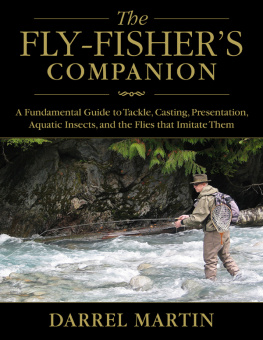
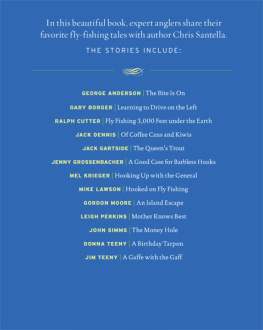

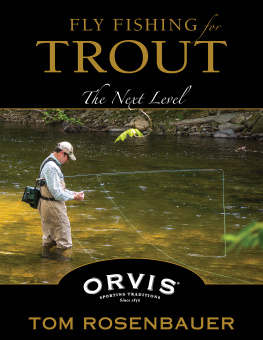

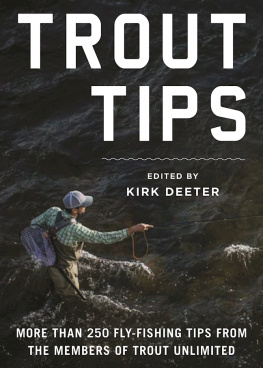
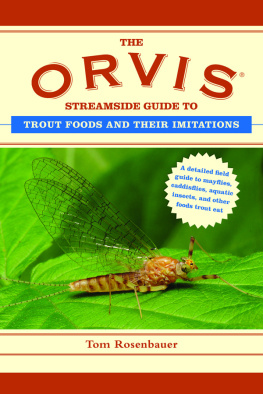
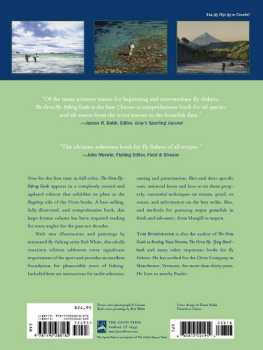

 The paper used in this publication meets the minimum requirements of American National Standard for Information SciencesPermanence of Paper for Printed Library Materials, ANSI/NISO Z39.48-1992.
The paper used in this publication meets the minimum requirements of American National Standard for Information SciencesPermanence of Paper for Printed Library Materials, ANSI/NISO Z39.48-1992.